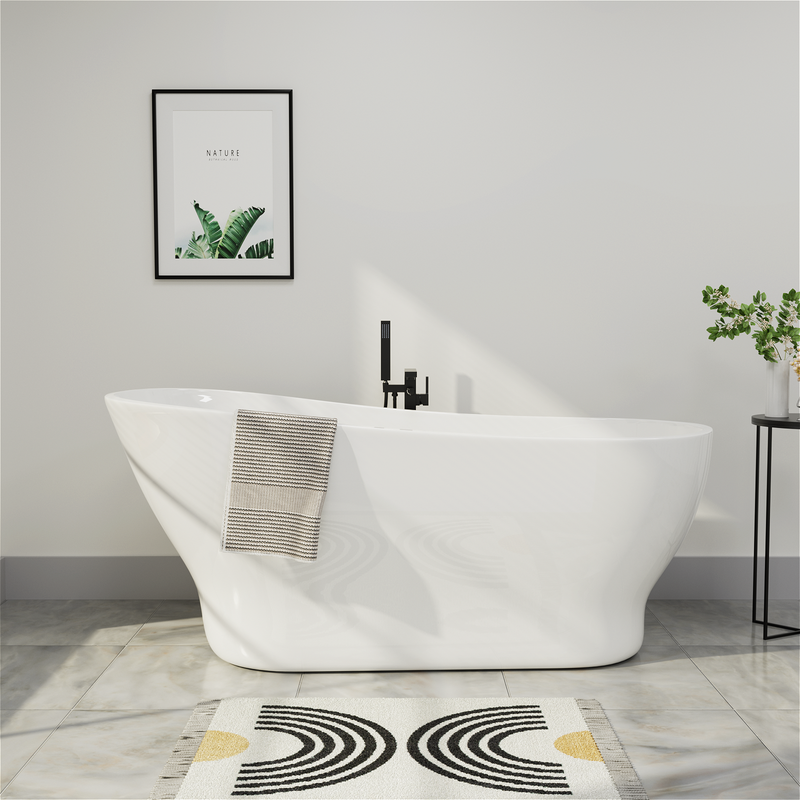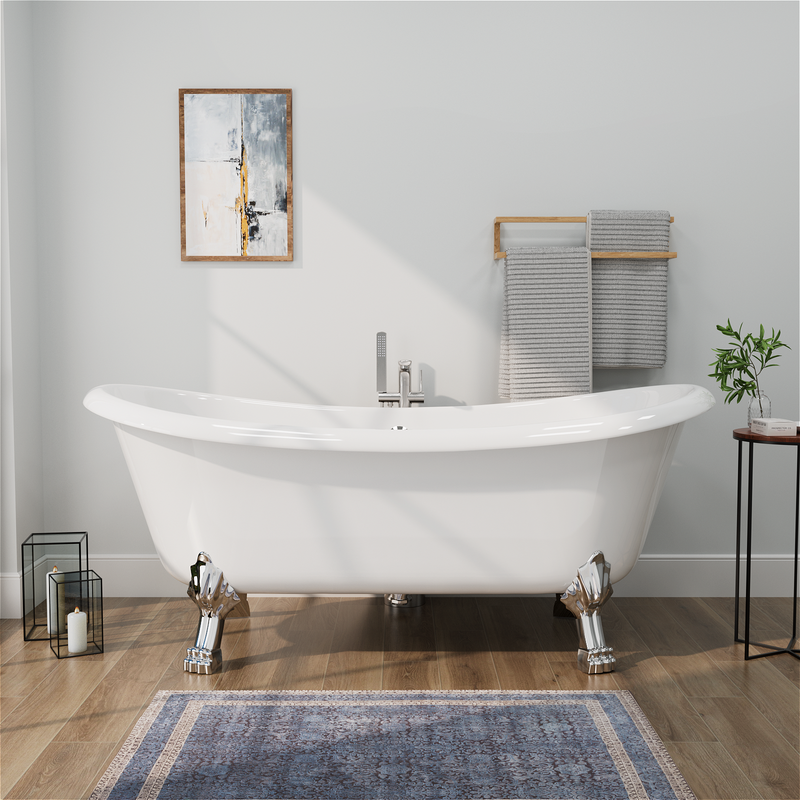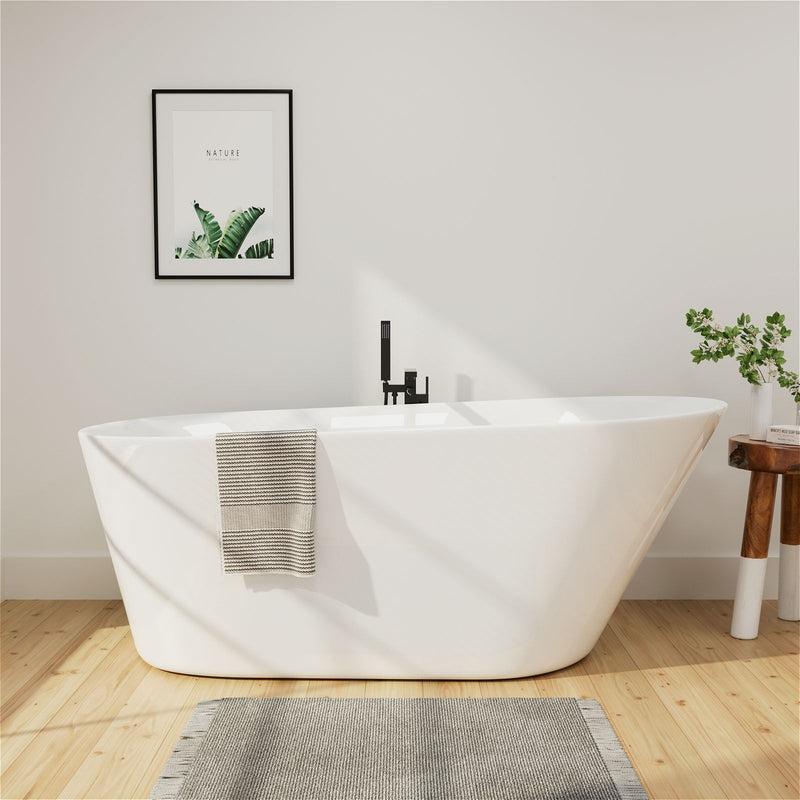When planning a bathroom renovation, the choice between acrylic and copper bathtubs presents distinct considerations for homeowners. Each material offers different benefits regarding daily use, maintenance requirements, and financial investment. Acrylic represents modern manufacturing approaches with practical benefits for contemporary living, while copper brings traditional craftsmanship and natural material characteristics.
This comparison examines acrylic and copper bathtubs through factual information about material properties and user experiences. We'll explore how these materials differ in practical use, cleaning needs, temperature behavior, and long-term value to help determine which option suits specific bathroom requirements and personal preferences.
Material Composition and Production Methods
The basic differences between these bathing options begin with their material structure and manufacturing processes, which significantly influence their final characteristics.
Acrylic bathtubs utilize molded synthetic materials, typically featuring a PMMA plastic surface supported by fiberglass reinforcement. This layered construction provides durability while allowing design flexibility. The manufacturing process heats acrylic sheets until flexible, then vacuum-forms them over molds to create various shapes and sizes. This approach enables efficient production and diverse design possibilities, making the material accessible for different bathroom layouts and budgets.
Standard acrylic tubs generally measure 3-10mm in thickness, with higher quality models at the upper end of this range. The back of the acrylic surface usually receives fiberglass resin reinforcement for additional structural strength. This production method accommodates numerous design forms, from basic rectangular models to sophisticated shapes incorporating built-in seating, armrests, and body-contouring features.

Copper bathtubs employ traditional metalworking methods, crafted from solid copper sheets. Unlike the molded production of acrylic units, copper bathtubs frequently involve hand-forming by skilled artisans using techniques like hammering and welding. This labor-intensive manufacturing approach substantially increases costs but produces unique pieces with individual characteristics.
Copper's natural qualities include inherent antimicrobial properties that can restrict bacterial development. The material naturally develops a patina over time—a surface layer forming through oxidation that gives each tub a distinctive look that evolves with age and usage. While some copper tubs retain a bright polished finish through protective coatings, numerous owners value the developing natural patina that emerges with repeated use and moisture exposure as part of the material's appeal.
Thermal Properties and Usage Experience
The daily bathing experience differs significantly between acrylic and copper tubs due to their varying physical characteristics, particularly regarding heat management and sensory aspects.
Acrylic bathtubs deliver immediate comfort through their thermal characteristics. The material feels warm at first contact, preventing the temperature surprise that can happen with more conductive substances. This makes acrylic especially appropriate for colder environments or for people who prefer impromptu bathing without pre-warming the surface. Acrylic provides decent heat retention, helping sustain water temperature during an average bathing session because of its low thermal conductivity.
Acrylic tub surfaces are naturally smooth and non-absorbent when properly finished, making them simple to clean and resistant to discoloration. Acrylic's lighter weight compared to metal options makes installation potentially easier and permits more adaptable bathroom arrangements, including upper-level installations where weight might present concerns. The material possesses slight natural flexibility that some users find offers comfortable support during use.
Copper bathtubs provide a distinctive sensory experience based on their metallic composition. Copper feels cool initially but rapidly conducts heat from bathwater, potentially establishing a uniformly warm soaking environment. The material's exceptional thermal conductivity efficiently transfers heat across the tub surface, which some bathers value for its consistent warmth distribution during use.
However, this same thermal conductivity means water might cool somewhat faster than in acrylic tubs unless the copper receives insulation, since the metal readily transfers heat to the surrounding air. Many copper tub manufacturers counter this by applying insulation materials to the exterior. Copper's natural metallic surface delivers a firm, substantial feel that many enthusiasts consider premium and grounding. The material develops a characteristic patina over time that many owners view as part of its visual appeal, though this demands particular maintenance methods to preserve if a consistent look is preferred.
Longevity and Care Requirements
Ongoing ownership satisfaction depends considerably on how each material endures regular use and what maintenance it demands, with both options presenting different care profiles.
Acrylic bathtubs provide uncomplicated maintenance with their non-absorbent surface that resists discoloration and allows cleaning with gentle soap and soft fabrics. A practical benefit of acrylic involves its repairability—minor surface marks can frequently be treated with polishing compounds made specifically for acrylic surfaces, potentially renewing the original look without expert help.
With proper care, quality acrylic tubs normally deliver dependable service for 15-20 years. They do need protection from harsh cleaners or coarse materials that could gradually reduce their glossy finish. Prevent exposing acrylic surfaces to very high temperatures, such as from cigarettes or hot styling instruments, which might cause damage. The material could be vulnerable to surface harm from sharp impacts or heavy abrasive contact.
Copper bathtubs present different durability factors. The material naturally resists microbial growth, offering an inherent hygiene advantage. Copper's structural strength enables it to endure decades of use when properly maintained, with some antique examples remaining functional after many years. However, copper requires specific care practices to maintain its appearance according to owner preferences.

Many owners value the natural patina that forms over time, while others prefer keeping the original shine through regular polishing with suitable products. The metal can develop scratches that some regard as part of its character, though serious damage might need professional attention. Water chemistry can also influence copper surfaces, potentially needing specific water treatment or more frequent cleaning in regions with mineral-rich water to maintain desired appearance.
Installation and Budget Considerations
The practical installation needs and financial aspects vary substantially between these bathtub materials, affecting both initial setup and extended ownership expenses.
Acrylic bathtubs offer installation benefits because of their comparatively light weight versus metal alternatives. A standard acrylic tub can often be installed without structural changes to most bathroom floors, making them appropriate for various home configurations including upper-level bathrooms. The reduced weight simplifies handling and positioning during installation, potentially decreasing labor time and related costs.
From a financial perspective, acrylic tubs normally represent a more accessible investment regarding both initial purchase price and installation expenses. The manufacturing process and material costs make acrylic a practical choice for various budget ranges while maintaining performance standards for reliable daily use.
Copper bathtubs constitute a substantial financial commitment at multiple levels. The material itself carries significant cost, and the specialized craftsmanship involved in production further raises the purchase price. These tubs have considerable weight, often requiring professional evaluation of structural support and potentially needing floor reinforcement, particularly for installations above ground level.
The installation process demands specific expertise to manage the weight properly and ensure correct plumbing connections. The complete investment for a copper tub includes both the premium purchase price and specialized installation requirements, placing it firmly in the luxury product category. Owners should also consider extended maintenance costs, including specialized cleaning products and potential professional polishing services to maintain the desired appearance.
Mokleba's Focus on Acrylic Manufacturing
At Mokleba, our concentration remains on creating bathtubs that blend visual appeal with practical performance for everyday life. We've selected to specialize in high-grade acrylic through thoughtful consideration of what delivers most homeowners the optimal balance of comfort, durability, and value in their bathing products.
Our acrylic bathtubs incorporate contemporary manufacturing methods that improve structural strength while preserving the material's inherent benefits. We employ premium acrylic sheets with stabilizers to guard against discoloration, ensuring your tub maintains its appearance through years of use. The non-absorbent surface of our acrylic tubs resists staining and enables simple cleaning, fitting smoothly into busy lifestyles while supporting household hygiene.
We've determined that acrylic provides the optimal combination of warm surface feel, design adaptability, and manageable maintenance that serves most homeowners effectively through years of reliable use. The material's formability enables us to create ergonomic designs that support comfortable bathing positions while maintaining efficient space utilization. Our manufacturing strategy focuses on maximizing the material's inherent advantages while addressing its limitations through structural reinforcement and quality control measures.
FAQs
What are the realistic maintenance cost differences between acrylic and copper tubs over five years?
Acrylic maintenance mainly involves cleaning supplies and occasional polishing materials, representing minimal continuing costs. Copper needs specialized cleaning products and potentially professional polishing services, with five-year maintenance costs normally surpassing acrylic's by several hundred percent because of material-specific care requirements.
Do acrylic tubs develop distinctive character like copper over time?
Acrylic maintains a more uniform appearance, developing minimal character marks compared to copper's evolving patina. While some prefer copper's changing look, others value acrylic's stable visual qualities that stay closer to their original condition throughout years of use.
Which material performs better in households with children?
Acrylic normally suits family bathrooms better because of its warm initial temperature, impact resistance, and straightforward cleaning needs. The consistent surface temperature and simple maintenance accommodate family use demands effectively while providing a comfortable bathing environment.
How often does copper need polishing to preserve its original appearance?
Professional recommendations indicate polishing copper tubs every 2-3 months to maintain their original shine, though many owners accept the natural patina development with less frequent care. This represents considerably more maintenance than acrylic surfaces require, which generally need only routine cleaning.
Do these materials respond differently to standard bathroom cleaning products?
Acrylic works well with most mild, non-abrasive cleaners available at regular stores. Copper demands specific, non-abrasive metal cleaners to avoid damaging the surface, limiting product options and potentially raising maintenance costs over time.
What is the actual weight difference between similar-sized acrylic and copper tubs?
Copper tubs typically weigh 3-5 times more than comparable acrylic models, creating significantly different installation requirements and potential structural considerations for your bathroom. This weight difference often requires professional assessment for copper installations.
How does each material influence bathroom temperature and humidity conditions?
Copper's thermal conductivity might help moderate bathroom temperature variations slightly, while acrylic has minimal effect on ambient temperature conditions. Both materials function effectively in standard bathroom humidity levels when adequate ventilation exists.
Determining Your Material Choice
Deciding between acrylic and copper bathtubs involves assessing practical factors against visual preferences and financial parameters. Acrylic provides functional benefits through its manageable weight, comfortable surface temperature, design variety, and simpler maintenance needs. It represents a practical selection for homeowners seeking reliable performance, straightforward upkeep, and cost-effective installation without compromising bathing comfort.
Copper offers unique natural material advantages, including inherent microbial resistance, distinctive appearance, and potential lifetime durability. This option appeals to those appreciating artisan craftsmanship and traditional materials, understanding it demands greater maintenance commitment and represents a more substantial financial investment in both product and installation.
Consider your household's specific bathing patterns, maintenance capabilities, and financial parameters when evaluating these options. By comprehending the practical distinctions between these materials, you can choose a bathtub that aligns with your lifestyle needs and delivers satisfying performance through years of use, whether you prioritize the practical benefits of acrylic or the distinctive qualities of copper.





